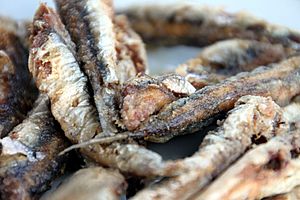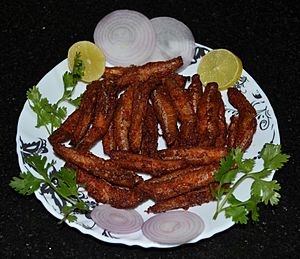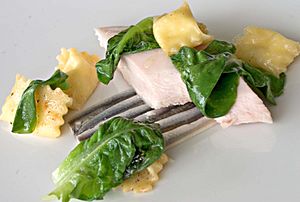Anchovy facts for kids
Quick facts for kids Anchovies |
|
|---|---|
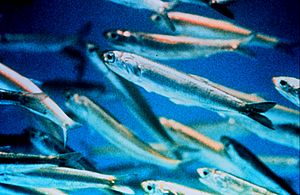 |
|
| Scientific classification | |
| Kingdom: | |
| Phylum: | |
| Superclass: | |
| Class: | |
| Order: | |
| Family: |
Engraulidae
|
An anchovy is a small, common fish that lives in large groups. It belongs to the Engraulidae family. Most anchovies live in the ocean. However, some can be found in brackish water, which is a mix of fresh and salt water. A few types in South America even live only in fresh water.
There are over 140 different kinds of anchovies. They are grouped into 17 genera. You can find them in the Atlantic, Indian, and Pacific Oceans. They also live in the Black Sea and the Mediterranean Sea. Anchovies are often called oily fish because they have a lot of healthy oils.
About Anchovies
The anchovy is a small, greenish fish. It has blue reflections on its sides. These shiny blue colors come from a silver stripe. This stripe runs along the fish's body, from its head to its tail.
Anchovies can grow up to nine inches long. Their body shape can change a bit. Fish in colder, northern areas tend to be thinner. They have a blunt snout and small, sharp teeth in both their upper and lower jaws. Anchovies eat tiny ocean creatures called plankton and also eat fish larvae.
These fish can live in many different temperatures. They can also handle a wide range of salinity, which is how salty the water is. You can find large groups of anchovies in shallow, brackish areas. They often like places with muddy bottoms, like estuaries and bays.
Anchovies lay their eggs, a process called spawning, between October and March. They do not spawn in water colder than 12 degrees C. Anchovies usually lay their eggs about 100 kilometers from the shore. They do this near the surface of the water.
Anchovies as Food
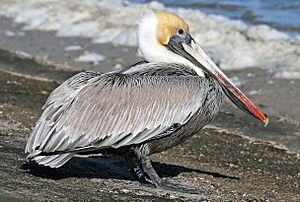
Anchovies are a very important food source. Many predatory fish eat them. These include the California halibut, rock fish, yellowtail, sharks, and chinook and coho salmon.
They are also vital for marine mammals and birds. For example, California brown pelicans and elegant terns rely on anchovies. When there are many anchovies, these birds have more success raising their young. If the anchovy population goes down, the animals that eat them also tend to decrease.
Humans also eat anchovies. Anchovies are often preserved by being cleaned and salted in brine, which is very salty water. Then they are left to mature and finally packed in oil. These preserved anchovies are a popular food. They are known for their very strong flavor.
In Roman times, anchovies were used to make a fermented fish sauce called garum. This sauce was a main part of their cooking. It was also traded over long distances and made in large amounts.
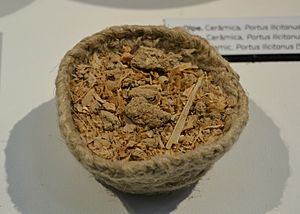
Today, anchovies are a key ingredient in Caesar salad. They are also used in Spaghetti alla Puttanesca. Many people like them as a pizza topping. Because of their strong taste, they are also used in many sauces. These include Worcestershire sauce and many fish sauces. Some versions of Café de Paris butter also use anchovies.
You can often find anchovies sold in small tins. They come as "flat" fillets or as "rolled anchovies." Rolled anchovies have each fillet wrapped around a caper. Both types are quite salty. The flat fillets are usually saltier than the rolled ones. Anchovies are also sold in jars and tubes as a paste. This paste is mostly used for making sauces, like anchovy essence.
Fishermen also use anchovies as bait. They use them to catch bigger fish like tuna and sea bass.
The strong taste that many people know about anchovies comes from the curing process. Fresh anchovies, called alici in Italy, have a much milder and gentler flavor. In English-speaking countries, alici are sometimes called "white anchovies." They are often served in a light vinegar marinade.
A special way of preserving white anchovies comes from Collioure. This is a coastal town in south-east France. These white fillets are sold in heavy salt. More popular are the ones packed in garlic or tomato oil and vinegar marinade.
The European anchovy is the type most often used in trade. Morocco is now the world leader in canned anchovies. The anchovy industry along the coast of Cantabria is much larger than the older Catalan salters. However, the industry in Cantabria was only started in the mid-19th century by salters from Sicily.
Setipinna taty, also known as ikan bilis, is a common anchovy in South-East Asian cooking. It is used to make fish stock or sambals. Anchovy is also used to make budu through a fermentation process.
Images for kids
-
European anchovy, Engraulis encrasicolus
See also
 In Spanish: Engráulidos para niños
In Spanish: Engráulidos para niños



